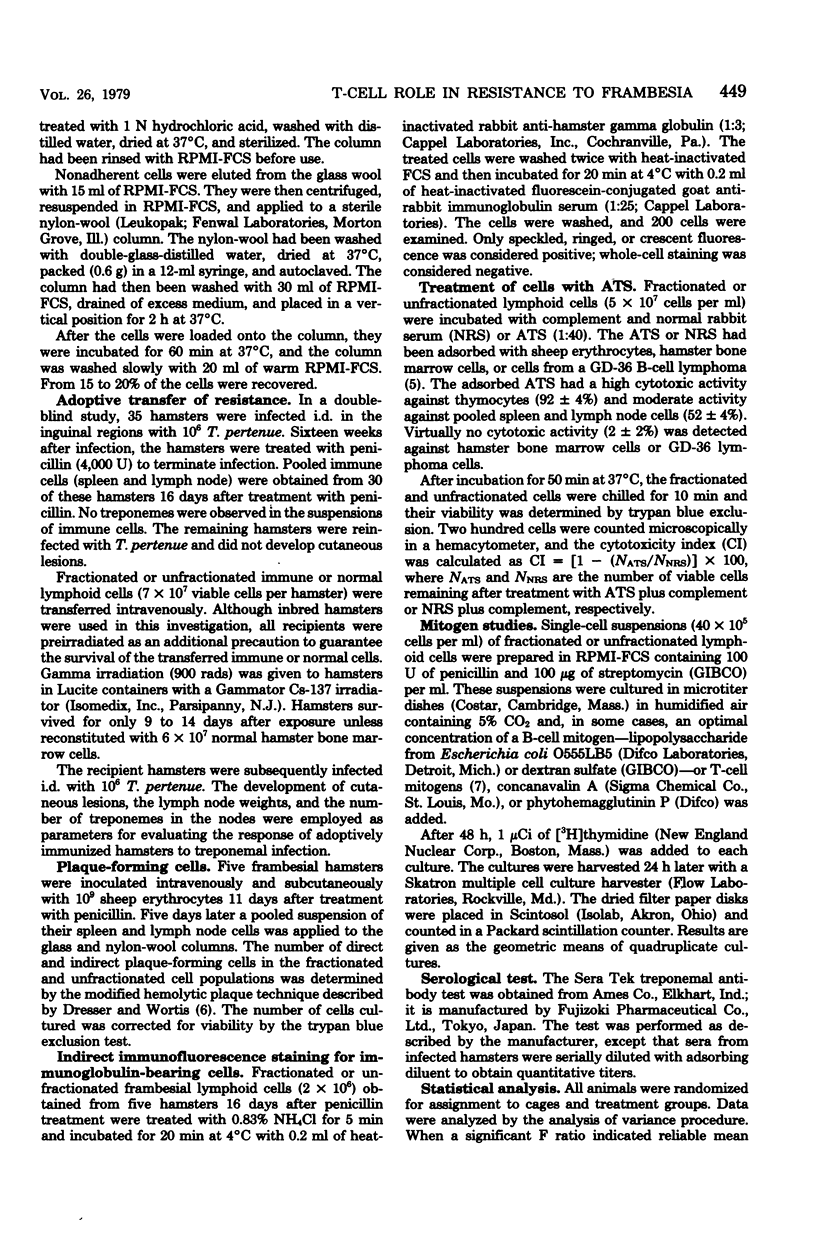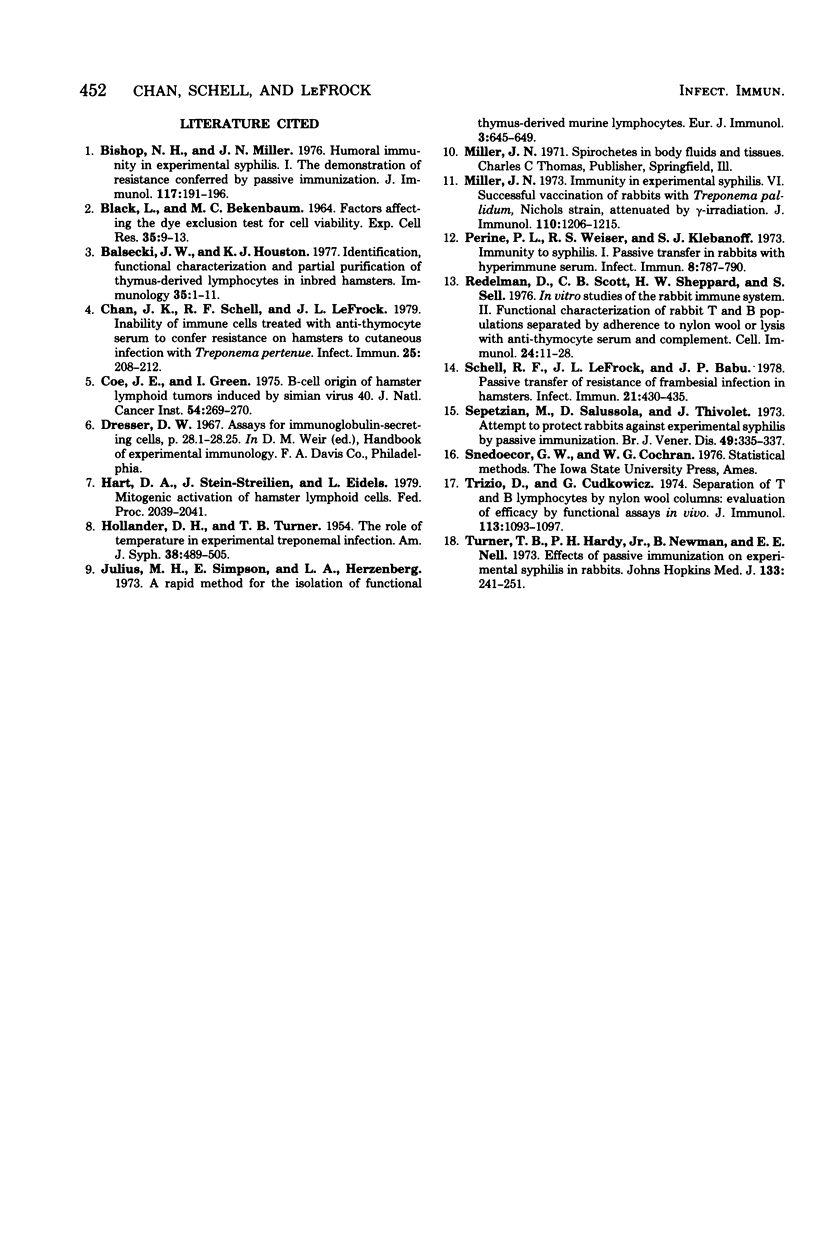Abstract
This investigation presents the first direct evidence that T cells are involved in resistance to challenge with Treponema pertenue. Enriched T cells from immune hamsters were obtained by sequential filtration through glass and nylon-wool columns. This procedure removed the majority of functional antibody-producing and immunoglobulin-bearing cells. The fractionated cell suspensions were less responsive to stimulation by phytohemagglutinin, lipopolysaccharide, and dextran sulfate, but they were enriched with antithymocyte-sensitive cells and were more responsive to stimulation with concanavalin A. Hamsters receiving fractionated or unfractionated immune cells had no cutaneous lesions 21 days after infection and had significantly lower lymph node weights and fewer treponemes per node than hamsters that received fractionated or unfractionated normal cells. Resistance was transferred with immune cell suspension enriched in T cells despite an absence of anamnestic antibody response to specific treponemal antigens.
Full text
PDF




Selected References
These references are in PubMed. This may not be the complete list of references from this article.
- BLACK L., BERENBAUM M. C. FACTORS AFFECTING THE DYE EXCLUSION TEST FOR CELL VIABILITY. Exp Cell Res. 1964 Jun;35:9–13. doi: 10.1016/0014-4827(64)90066-7. [DOI] [PubMed] [Google Scholar]
- Bishop N. H., Miller J. N. Humoral immunity in experimental syphilis. I. The demonstration of resistance conferred by passive immunization. J Immunol. 1976 Jul;117(1):191–196. [PubMed] [Google Scholar]
- Blasecki J. W., Houston K. J. Identification, functional characterization and partial purification of thymus-derived lymphocytes in inbred hamsters. Immunology. 1978 Jul;35(1):1–11. [PMC free article] [PubMed] [Google Scholar]
- Chan J. K., Schell R. F., LeFrock J. L. Inability of immune cells treated with anti-thymocyte serum to confer on hamsters resistance to cutaneous infection with Treponema pertenue. Infect Immun. 1979 Jul;25(1):208–212. doi: 10.1128/iai.25.1.208-212.1979. [DOI] [PMC free article] [PubMed] [Google Scholar]
- Coe J. E., Green I. B-cell origin of hamster lymphoid tumors induced by simian virus 40. J Natl Cancer Inst. 1975 Jan;54(1):269–270. doi: 10.1093/jnci/54.1.269. [DOI] [PubMed] [Google Scholar]
- HOLLANDER D. H., TURNER T. B. The role of temperature in experimental treponemal infection. Am J Syph Gonorrhea Vener Dis. 1954 Nov;38(6):489–505. [PubMed] [Google Scholar]
- Julius M. H., Simpson E., Herzenberg L. A. A rapid method for the isolation of functional thymus-derived murine lymphocytes. Eur J Immunol. 1973 Oct;3(10):645–649. doi: 10.1002/eji.1830031011. [DOI] [PubMed] [Google Scholar]
- Miller J. N. Immunity in experimental syphilis. VI. Successful vaccination of rabbits with Treponema pallidum, Nichols strain, attenuated by -irradiation. J Immunol. 1973 May;110(5):1206–1215. [PubMed] [Google Scholar]
- Perine P. L., Weiser R. S., Klebanoff S. J. Immunity to syphilis. I. Passive transfer in rabbits with hyperimmune serum. Infect Immun. 1973 Nov;8(5):787–790. doi: 10.1128/iai.8.5.787-790.1973. [DOI] [PMC free article] [PubMed] [Google Scholar]
- Redelman D., Scott C. B., Sheppard H. W., Jr, Sell S. In vitro studies of the rabbit immune system: II. Functional characterization of rabbit T and B populations separated by adherence to nylon wool or lysis with anti-thymocyte serum and complement. Cell Immunol. 1976 Jun 1;24(1):11–23. doi: 10.1016/0008-8749(76)90127-1. [DOI] [PubMed] [Google Scholar]
- Schell R. F., Le Frock J. L., Babu J. P. Passive transfer of resistance to frambesial infection in hamsters. Infect Immun. 1978 Aug;21(2):430–435. doi: 10.1128/iai.21.2.430-435.1978. [DOI] [PMC free article] [PubMed] [Google Scholar]
- Sepetjian M., Salussola D., Thivolet J. Attempt to protect rabbits against experimental syphilis by passive immunization. Br J Vener Dis. 1973 Aug;49(4):335–337. doi: 10.1136/sti.49.4.335. [DOI] [PMC free article] [PubMed] [Google Scholar]
- Trizio D., Cudkowicz G. Separation of T and B lymphocytes by nylon wool columns: evaluation of efficacy by functional assays in vivo. J Immunol. 1974 Oct;113(4):1093–1097. [PubMed] [Google Scholar]
- Turner T. B., Hardy P. H., Jr, Newman B., Nell E. E. Effects of passive immunization on experimental syphilis in the rabbit. Johns Hopkins Med J. 1973 Nov;133(5):241–251. [PubMed] [Google Scholar]


